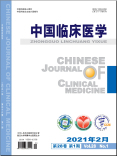中国临床医学2024,Vol.31Issue(2):200-207,8.DOI:10.12025/j.issn.1008-6358.2024.20231773
基于冠状动脉CT血管造影的斑块特征指数对稳定性冠心病患者病变特异性心肌缺血的诊断价值
Diagnostic value of plaque feature index based on coronary CT angiography for lesion specific myocardial ischemia in stable coronary heart disease patients
摘要
Abstract
[Abstract]Objective To explore the predictive value of plaque characteristic index based on coronary CT angiography(CCTA)for disease-specific myocardial ischemia in stable coronary artery disease(CAD).Methods 90 stable CAD patients admitted to Zhongshan Hospital,Fudan University from October 2020 to March 2022 were prospectively enrolled,including 135 target vessels with stenosis degree ranging from 30%to 90%.All participants sequentially underwent CCTA,ICA,and fractional flow reserve(FFR)measurement within 2 weeks.Based on the presence or absence of significant hemodynamic stenosis,all patients were divided into myocardial ischemic population(FFR≤0.8,n=30)and non ischemic population(FFR>0.8,n= 60),135 target blood vessels were divided into a disease-specific myocardial ischemia group(FFR≤0.8,n=36)and a non disease-specific myocardial ischemia group(FFR>0.8,n=99).Univariate and subsequent forward stepwise multivariate logistic regression analyses were used to assess independent predictors of myocardial ischemia,and CCTA-derived plaque characteristics index logistic regression model was created.Receiver operating characteristic(ROC)analysis was used to analyze the diagnostic performance of CCTA-derived plaque characteristics index on detecting myocardial ischemia.Results There were no significant differences in age,body mass index,gender,cardiovascular risk factors,and medication between myocardial ischemia population and non-ischemia population.Compared with the non-lesion-specific ischemia group,plaque length,plaque area,percent area stenosis,total atheroma volume,vessel volume and lipid rich volume,positive remodeling and napkin-ring signs were significantly higher in lesion-specific group,while minimum luminal area(MLA)was significantly lower.MLA(OR=0.303,95%CI 0.178-0.517,P<0.001)and total atheroma volume(TAV,OR=1.006,95%CI 1.002-1.010,P=0.003)were found to be the significant independent predictors of myocardial ischemia.The regression equation of CCTA-derived plaque characteristic index for predicting probability was P=1/[1+e-(-1.194 41×MLA+0.006 058×TAV+0.600 912)].The area under the ROC curve(AUC)of CCTA-derived plaque characteristic index on detecting myocardial ischemia was 0.879(95%CI 0.811-0.928),and the overall diagnostic accuracy,sensitivity,specificity,PPV and NPV were 80.0%,83.3%,78.8%,58.8%,and 92.9%,respectively.Conclusions CCTA-derived plaque characteristic index performs well in diagnosing lesion-specific myocardial ischemia,showing its great clinical application prospect.关键词
冠心病/心肌缺血/冠状动脉CT血管造影/斑块特征指数/诊断效能Key words
coronary artery disease/myocardial ischemia/coronary CT angiography/plaque characteristics/diagnostic performance分类
临床医学引用本文复制引用
徐海嘉,何玮,过伟锋,杨姗,都业弘,陆海锋..基于冠状动脉CT血管造影的斑块特征指数对稳定性冠心病患者病变特异性心肌缺血的诊断价值[J].中国临床医学,2024,31(2):200-207,8.基金项目
上海市临床重点专科项目(shslczdzk03202).Supported by Shanghai Municipal Key Clinical Specialty Project(shslczdzk03202). (shslczdzk03202)

